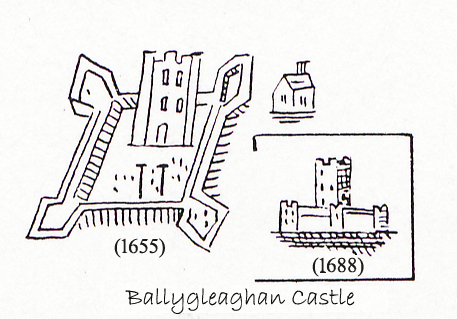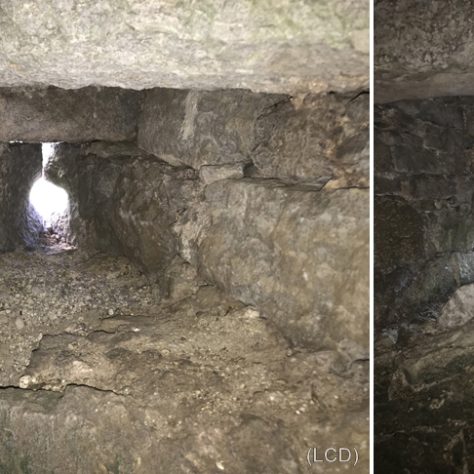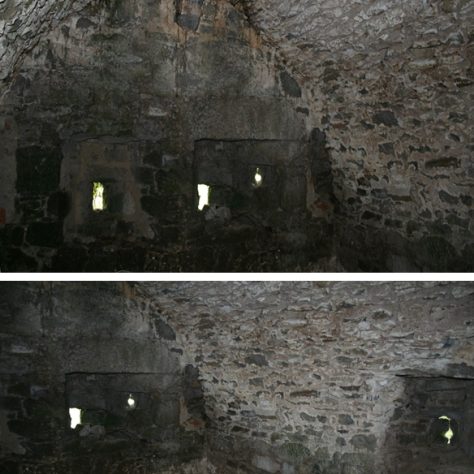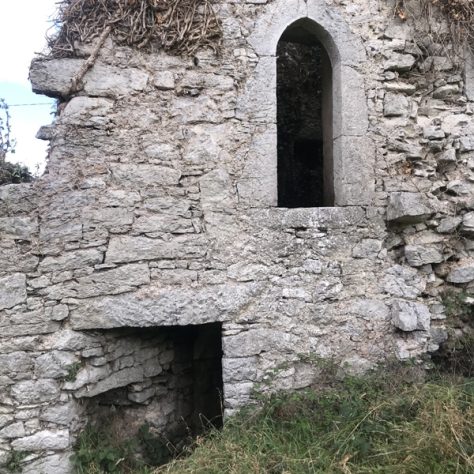BALLYGLEAGHAN CASTLE
Traditional Irish Name
Baile Uí Gheileacháin – town of Ó Geileacháin.
Associated Families
FitzGerald/Knights of Glin.
Taylor.
Location
| Barony | Kenry. |
| Civil Parish | Kilcornan. |
| Townland | Curragh Chase (North). |
| OS Map Ref | Sheet 20. |
Protected Structure Record
Reg. No: 305.
Ref. No: B11(25).
Description
Ballygleaghan Castle was a traditional FitzGerald stronghold, held under successive knights of Glin.
Ballygleaghan (like Ballyculhane Castle) is now a keepless site; but part of the court, or bawn wall, and two of the original four turrets, or flankers are extant.
The castle is shown on the 17th-century Down Survey and Trustee maps (see sketch in Image Gallery) ‘as a strong peel tower in a square court, with turrets at each corner.’1
Ballygleaghan was once ‘an imposing tower house,’ as Colm Donnelly observed, ‘well defended by a rectangular bawn and four corner flankers’. These flankers ‘are positioned at what were the south-east and the north-west corners of the bawn’ and probably date from the late sixteenth or early seventeenth century.2
They are numerous shot-hole or gun-loops, placed at almost every angle, in both flankers (marked A and B in Image Gallery).
Condition
The castle was still in very good condition in 1703, but was demolished in the later 18th century and replaced by Hollypark House. As noted above, two of the four flankers were kept, along with a section of the bawn wall.
Access
The castle site is occupied by a private house. Permission is required.
Historical Timeline
| 1569: | Ballygleaghan Castle is held by Edmund FitzDavid FitzGerald when it surrendered to English forces. |
| 1570: | FitzGerald named as one of the principal freeholders and gentlemen in County Limerick, and is pardoned by the crown. |
| 1573: | FitzGerald takes English soldiers captive. |
| 1580: | During the Desmond rebellion, Ballygleaghan was the last castle holding out against crown forces in Munster. When the castle was finally taken (April 1580), Sir William Pelham, lord justice of Ireland, triumphantly wrote to Elizabeth I from nearby Askeaton: “Yesterday certain bands, being sent abroad for forage, came before the Castle of [Ballygleaghan], which hath this year past been warded by the Earl [of Desmond], but upon view of the [royal] ensigns they also fired the house and escaped; so as now there is not any house in Munster kept against your Majesty, but wholly at your devotion.”3 |
| 1581: | The FitzGeralds of Ballygleaghan are pardoned. |
| 1584: | Castle and lands seized by the English crown. |
| 1600-01: | The family is again pardoned by the crown. |
| 1604: | Castle and lands held by Thomas FitzGerald, knight of Glin. |
| 1655: | Late estate of Gerald FitzGerald. |
| 1668: | Granted by Charles II to his brother, James, duke of York. |
| 1703: | Estate granted to William Taylor following the death of James II. Ballygleaghan becomes better known as Hollypark from the 18th century. |
1 Westropp, ‘Ancient Castles … Limerick’, 145.
2 Colm Donnelly, ‘The Tower Houses of County Limerick’, Doctoral thesis (Queens University Belfast, 1995).
3 Carew Manuscripts, 1575-1588, 241.
Notes
All historical information is compiled from archival material; primary sources (such as State Papers); secondary sources; plus authoritative digital sources (such as CELT). Any direct quote or a further reading suggestion is footnoted.
For queries, suggested amendments, or other relevant information, or if you would like to contribute an archival image of Ballygleaghan Castle (of which you own the copyright), please leave a comment at the bottom of the page, or email (below).
limerickcastlesdatabase@gmail.com
Image Gallery
Images can be viewed individually or on a slideshow. To quit: hit ‘esc’ on keyboard, or simply click away from image.
Slideshows are best viewed using keyboard arrow keys: L-R to go back and forward.
If you have any difficulty in viewing images, please contact us (above).




























Comments about this page
Sonja.
Ballygleaghan is one of only a handful of castle sites within the county of Limerick, with surviving defensive flankers, and remaining sections of the bawn wall.
Great pictures with useful information
Add a comment about this page